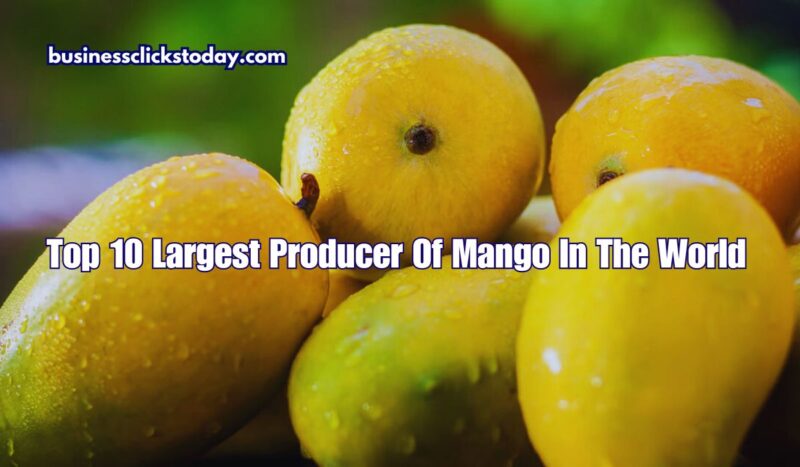The mango, often hailed as the “King of Fruits,” holds a special place in the hearts of people across the globe. Its vibrant sweetness and remarkable versatility make it a beloved fruit, enjoyed in numerous forms from salsas to smoothies. The mango’s pulpy flesh, whether it’s the honeyed Alphonso or the buttery Ataulfo, offers a symphony of tropical flavors that captivate taste buds worldwide. Beyond its delectable taste, mangoes are a treasure trove of vitamins, antioxidants, and fiber, making them a nutritious choice. Given their seasonal nature, mangoes bring an element of excitement and anticipation, adding to their global popularity. As we approach 2024, the world’s mango supply continues to be shaped by leading producing nations, each contributing significantly to the global mango market. Let’s delve into the countries that are the Largest Producer Of Mango In The World.
Top 10 Largest Producer Of Mango In The World

1. India – 25 Million Metric Tons
India reigns supreme as the largest producer of mangoes in the world, with an impressive 25 million metric tons of mangoes cultivated annually. Indian mango orchards are renowned for their diversity, yielding mangoes with various degrees of sweetness and flavors. The Alphonso and Kesar varieties are particularly famous, cherished both domestically and internationally. The Alphonso mango, often referred to as the “Hapus”, is celebrated for its rich, creamy texture and exceptional flavor. The Kesar mango, known for its bright orange color and sweet taste, is another favorite. Indian mango production reflects not just the scale but also the skill of its farmers, who blend traditional techniques with modern advancements to maintain the industry’s global prominence.
2. China – 3.8 Million Metric Tons
China stands as the second-largest mango producer, with a production volume of 3.8 million metric tons. The country’s vast mango orchards benefit from favorable weather conditions, contributing to its growing presence in the global mango market. China’s mango production is rapidly expanding, driven by the increasing demand for this tropical fruit. The country’s well-organized farming practices and optimal growing conditions facilitate the cultivation of diverse mango varieties, meeting both domestic and international needs. China’s significant role in mango production underscores its agricultural capabilities and its commitment to enhancing global supply chains and economic connections.
3. Indonesia – 3.6 Million Metric Tons
Indonesia ranks third in global mango production, yielding 3.6 million metric tons each year. The country’s tropical climate is ideal for growing mangoes, and varieties like Gedong Gincu and Manalagi are particularly noteworthy. These mangoes are celebrated for their unique flavors and are highly valued both locally and internationally. Indonesia’s mango industry showcases its agricultural richness and its ability to produce high-quality mangoes that cater to diverse tastes. The nation’s growing mango exports further strengthen its position in the global market, demonstrating the significant role of Indonesian mangoes in international trade.
4. Pakistan – 2.7 Million Metric Tons
With a production of 2.7 million metric tons, Pakistan is a key player in the global mango industry. Pakistani mangoes, especially the Chaunsa and Sindhri varieties, are renowned for their exceptional sweetness and aromatic qualities. The Chaunsa mango, often described as the “king of mangoes”, and the Sindhri mango are highly esteemed for their flavor profiles. Pakistan’s mango production reflects its agricultural expertise and dedication to maintaining high standards in mango cultivation. The country’s mangoes are cherished worldwide, contributing significantly to the global appreciation of this tropical fruit.
5. Mexico – 2.4 Million Metric Tons
Mexico is the fifth-largest producer of mangoes, with a production volume of 2.4 million metric tons. The country is particularly known for its Ataulfo mangoes, which are celebrated for their creamy texture and rich sweetness. Mexico’s geographical location near the equator extends the mango season, ensuring a steady supply to global markets. The country’s diverse climate and optimal growing conditions support a wide range of mango varieties, enhancing its global mango production capabilities. Mexico’s strategic position in the mango industry underscores its importance in meeting the world’s demand for this popular fruit.
6. Brazil – 2.1 Million Metric Tons
Brazil ranks sixth in mango production, with an annual output of 2.1 million metric tons. The Brazilian mango industry benefits from its tropical climate, which is conducive to growing varieties like Tommy Atkins and Palmer. These mangoes are known for their vibrant colors and sweet flavors. Brazil’s favorable growing conditions and year-round production contribute to its significant presence in the global mango market. The country’s diverse climate allows for the cultivation of various mango types, reinforcing its role as a major player in global mango production.
7. Malawi – 1.7 Million Metric Tons
Malawi, a rising star in mango production, contributes 1.7 million metric tons of mangoes annually. The country’s dedicated mango farming practices have established it as a significant mango producer. Varieties like Kent and Keitt are prominent in Malawi, known for their excellent quality and flavor. Malawi’s commitment to mango cultivation reflects its agricultural progress and its growing influence in the global mango market. The quality of Malawian mangoes, coupled with their international appeal, highlights the country’s potential as a key player in mango production.
8. Thailand – 1.6 Million Metric Tons
Thailand is the eighth-largest producer of mangoes, with a production volume of 1.6 million metric tons. Thai mangoes, such as Nam Dok Mai and Keo Savoy, are famous for their sweetness and fragrant aroma. The country’s tropical climate and advanced farming techniques contribute to its success in mango production. Thailand’s mango industry benefits from its ideal growing conditions and innovative agricultural practices, enabling it to meet both domestic and international demands. Thai mangoes are celebrated for their quality and flavor, making Thailand a significant contributor to the global mango market.
9. Bangladesh – 1.5 Million Metric Tons
Bangladesh produces 1.5 million metric tons of mangoes annually, ranking ninth in global production. Varieties like Langra and Fazli are integral to Bangladeshi mango culture, valued for their distinct flavors and versatility. The country’s mango industry showcases its agricultural expertise and commitment to producing high-quality mangoes. Bangladesh’s ability to serve both local and international markets underscores its role in the global mango industry. The unique characteristics of Bangladeshi mangoes contribute to their international reputation and demand.
10. Vietnam – 1.4 Million Metric Tons
Vietnam rounds out the top ten mango producers, with a production volume of 1.4 million metric tons. Vietnamese mangoes, including Cat Chu and Hoa Loc, are gaining recognition for their exceptional flavors. Vietnam’s dedication to agriculture and strategic cultivation practices support its position as a leading mango producer. The country’s mango industry reflects its commitment to quality and its growing influence in the global market. Vietnamese mangoes continue to make a significant impact, showcasing the country’s agricultural diversity and market potential.
Conclusion
As the Largest Producer Of Mango In The World, India leads the global mango industry with its vast production and diverse range of mango varieties. The top mango-producing countries, including India, China, Indonesia, and others, play a crucial role in shaping the global mango market. Their contributions not only enhance the richness of mango culture worldwide but also underscore the mango’s status as the undisputed “King of Fruits.” From India’s abundant orchards to Brazil’s tropical plantations, these nations collectively ensure that mangoes continue to delight and nourish people around the globe.
















